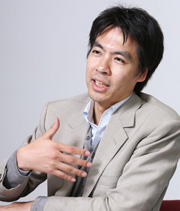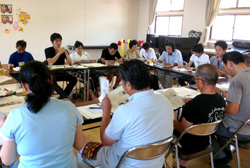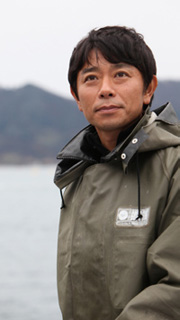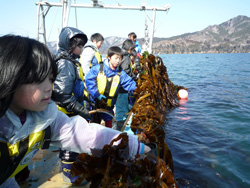Home > Highlighting JAPAN > Highlighting Japan MARCH 2013 > LEADING RECOVERY
Highlighting JAPAN
COVER STORY: LESSONS FROM DISASTERS
LEADING RECOVERY
After the Great East Japan Earthquake, many volunteers from around the country and the world came to the affected areas to lend support for the victims. Notably, many of them were young Japanese. As they took part in the volunteering, they began to involve themselves in efforts for the reconstruction of Tohoku based on a long-term vision and with the aim of creating a sustainable society. The Japan Journal's Osamu Sawaji reports on two young leaders genuinely devoted to reconstruction efforts in the affected areas.

Retz Fujisawa, representative director of the RCF Reconstruction Support Team and director for General Policy Planning with the Reconstruction Agency. Fujisawa conducts research, analyzes needs in the affected areas, and makes proposals with the aim of reflecting his findings in the national government's policies for reconstruction.
Credit: YUICHI ITABASHI
From the moment the Great East Japan Earthquake struck, the Japanese national government, local governments and citizens became active in efforts to help the victims, taking part in diverse activities that included rescuing victims and shipping relief supplies to evacuation centers. Yet the affected areas were faced with great confusion stemming from many different factors, such as the vastness of the affected areas and the massive number of victims. This kept evacuation centers from securing sufficient relief supplies, or caused unneeded supplies to be sent.
"I visited the affected area for the first time on March 20. Many people were working extremely hard at their support activities, but I felt that much of the information we needed was poorly communicated over the areas," says Retz Fujisawa, representative director of the RCF Reconstruction Support Team. "With the aim of helping volunteers efficiently provide assistance, I started gathering, analyzing and communicating information about what was going on, what kind of support was needed and where."
As a consultant, Fujisawa supported venture businesses and nonprofit organizations (NPOs). After the Great East Japan Earthquake, he set up the RCF Reconstruction Support Team and started efforts to support the affected areas. First, the RCF gained cooperation from NPOs supporting the areas and analyzed what was happening there. The NPOs used Twitter to assemble a total of 400 volunteers and spent three weeks gathering and analyzing information about food, sanitation and operation of nearly 600 evacuation centers. The RCF analyzed collected data and the results of the analysis were summarized into a report submitted to the partner NPOs, local governments and the national government. The analysis significantly helped supporters understand what kind of support was needed at the centers.

Touni, Kamaishi City residents, NPO members and local government officers gather to share information about reconstruction efforts, in a meeting facilitated by coordinators of the RCF Reconstruction Support Team.
Backed by foundations and businesses, the RCF continued a range of activities in the affected areas. Examples include a project for recording buildings that were partially destroyed by the earthquake and/or tsunami in cooperation with the major Internet search company Google. These building are demolished because of reconstruction efforts and consideration for the victims' feelings. The project involves photographing those buildings before they are demolished and storing the data digitally so that a record of the disaster can be handed down to future generations. As the project organizer, the RCF researched needs in local communities and gained the consent and support of nearly twenty local governments for photographing nearly fifty schools and municipal office buildings that were to be demolished.
These efforts were appreciated and the RCF began to receive more requests from businesses and local governments for supporting different reconstruction projects. Fujisawa increased the RCF's workforce, and now fifteen people, mostly in their twenties and thirties, work for the organization. Apart from the RCF, those in their thirties make up a large part of local governments, NPOs, companies and volunteers working at the forefront of reconstruction efforts.
One of the activities the RCF is currently focusing on is community assistance in Kamaishi, Iwate Prefecture. Three RCF members stay in Kamaishi as reconstruction coordinators and support the efforts uniting the local government and people. The coordinators' role is to serve as a bridge between them. Coordinators frequently participate in local meetings and events and take ample time trying to develop good relations with local people. The coordinators thus are able to uncover local people's wishes more adeptly than the local government.
"When everyone is concerned with a specific issue, it is sometimes hard for anyone to express honest feelings. This is when you need an outsider to find those feelings. That is what the reconstruction coordinator does," says Fujisawa. "Being involved in reconstruction efforts in an affected area means creating a new society, so to speak. This is a valuable experience for the whole world as well as for Japan. People who have this experience will become leaders in the future."

Takashi Tachibana of Oh!Guts!
Credit: KATSUHIRO ICHIKAWA
Ogatsu-cho in Ishinomaki, Miyagi Prefecture, is a small port town facing the Pacific Ocean. It is about a two-hour drive from Sendai, the central component of the prefecture. Before the great earthquake, scallops, oysters, sea squirts, silver salmon and many other fish and shellfish grew along the deeply indented coastline. Ogatsu-cho is also the producer of Ogatsu stone. Suzuri (inkstones) made from Ogatsu stone have a 600-year history and make up 90% of Japan's total inkstone production.
"Ogatsu is extremely rich in nature, food and traditional culture," says Takashi Tachibana, a member of a local company named Oh!Guts! "At night, an astounding spread of stars twinkles across the sky. Here you can also enjoy the soothing experience of watching the glowing sunrise and sunset."
One of the towns closest to the epicenter of the Great East Japan Earthquake, Ogatsu-cho was devastated by the tsunami. The town office building, elementary and junior high schools, fishery union buildings, stores and many other buildings that had stood in the central part of the town were wiped out by the tsunami. In August 2011, fishery workers set up Oh!Guts!
Besides hiring people both from Ogatsu and outside, Oh!Guts! trains fishermen, gives local children opportunities to experience fishermen's work and attracts sightseers. In this way, members of Oh!Guts! aim to mitigate social problems such as depopulation and industrial decline while generating profits from marine products, which is their primary job. The business style is unique among those of Japanese fishery-related companies. Tachibana is from Sendai and ran a company in Tokyo when the great earthquake hit. Right after the disaster, he headed for Sendai to confirm the safety of his mother and younger sister. Fortunately, both were alive. Tachibana immediately started cooking and providing meals in the affected areas and sending food to evacuation centers. As he repeated roundtrips between Tokyo and the affected areas, he met likeminded people in Ogatsu-cho and got involved in the founding of Oh!Guts!
"Our fishery activities are meant to work together with producers and consumers," Tachibana says. "In the past, fishermen had no idea who ate the fish they caught. We encourage consumers to visit Ogatsu as much as possible, aiming to nurture fisheries, the town itself and ties among people."
Oh!Guts! is supported by Sodateno Junin (literally, nurturing inhabitants), a group of consumers who buy, on a prepaid basis, scallops, seaweed, oysters, silver salmon and other fish and shellfish harvested by Ogatsu fishermen. Marine products are delivered to Sodateno Junin twice a year. The fishermen whose aquaculture equipment or tools were washed away by the tsunami used the money collected from advance payments from Sodateno Junin, to resume aquaculture in the fall of 2011. In addition to buying products, Sodateno Junin members are also entitled to participate in aquaculture experiences and other events organized by Oh!Guts!
Tachibana, wishing to show urban people what is happening in Ogatsu, has made more than 200 twice-weekly round trips of 450 kilometers each way between Tokyo and Ogatsu, carrying more than 1,000 people. Through these people, the Internet and media reports, Sodateno Junin now has over 3,000 members.

Local primary school students experience aquaculture in Ogatsu, Miyagi Prefecture.
Credit: COURTESY OF TAKASHI TACHIBANA
Also drawing attention from overseas media, Oh!Guts! has been covered by numerous reporters from countries like the United States, Spain, Germany and Taiwan. This past January, students of the Harvard Business School visited Ogatsu.
"Our activities are praised as very innovative in that we cooperate with producers, consumers, distribution industry and the restaurant industry in redeveloping a town and communities as well as establishing a new form of fishery," Tachibana explains. "These overseas visitors are amazed to find that Oh!Guts! gains involvement by so many people."
Oh!Guts! is scheduled to open a restaurant in Tokyo's Ginza district in May, which will serve seafood caught in the Tohoku waters. Tachibana currently stays in an old house when he is in Ogatsu. The house will be rebuilt into an inn serving fresh seafood. Indeed, many things that were unimaginable before the great earthquake are happening in succession in Ogatsu.
"In the future, hopefully, I will start a restaurant run by fishermen overseas," Tachibana says. "Today, depopulation and industrial decline are common problems for all local areas of Japan, including Ogatsu. These problems are also common on an international level. I wish for Ogatsu to serve as a model for the world as a solution to these problems."
© 2009 Cabinet Office, Government of Japan






